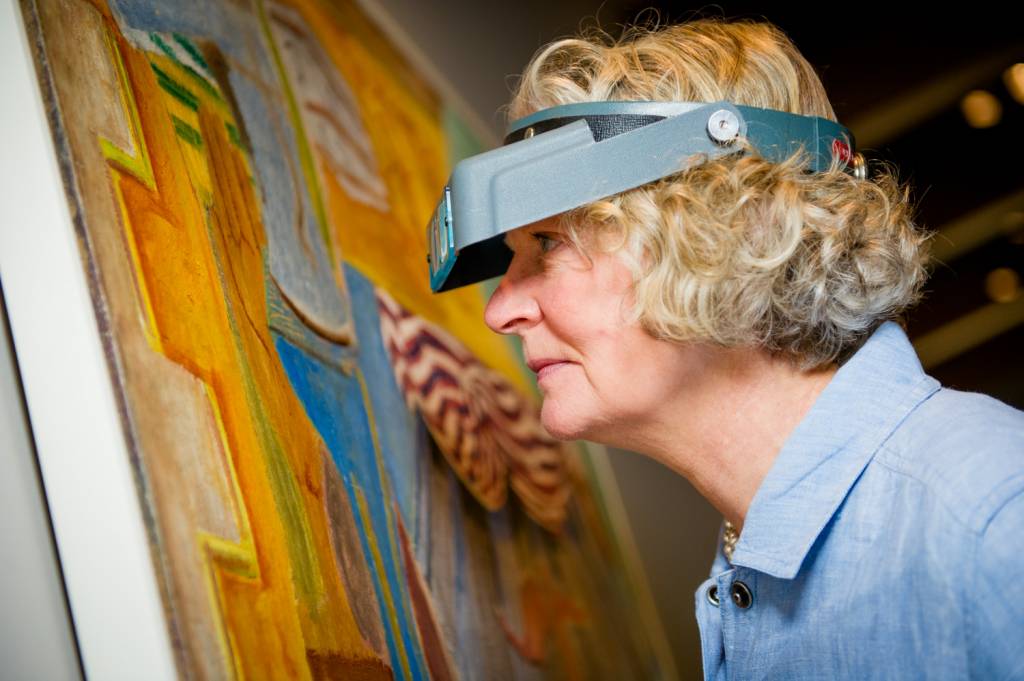In July, Lance Mayer and Gay Myers, a pair of painting conservators, visited Crystal Bridges to conduct a thorough assessment of all of the works currently on view in the galleries.
It is an unbelievably painstaking process in which the conservators, with illuminated magnifying loupes over their heads, stand for hours in the galleries, their faces mere inches from the paintings’ surfaces, carefully and closely inspecting every square inch of every painting in every gallery. At magnification, the paint surface becomes a miniature landscape in which every imperfection can be seen. As they go, they are making notes and annotations on photographs of each work indicating any area of paint loss, cracking, distortions to the paint, or areas that need cleaning.
It sounds grueling, but this pair find it fascinating, even invigorating.
“We’re having a lot of fun,” Gay said. “It’s great to spend such one-on-one time with the collection, and really to study it all. We feel like we’re doing the right job by doing this big base line survey, so from here on there’s something to compare. A lot of the older museums—with a lot of paintings in storage—they never really get around to looking at everything. It’s a really good thing. The collection here is limited in numbers enough so that we really can look at every painting.”
The idea is that by assessing every painting, the conservators can provide information that will not only allow the Museum’s registrar and curators to make informed decisions about which works should be first to receive conservation work; but provide information for future conservators that will allow them to track the rate of change in a painting’s condition.
“We can make note of some minor cracking and, maybe 20 or 50 years from now, some conservator will be happy to know if it’s advancing quickly or slowly,” Lance explained. “We always wish that we had better records from previous times. Often we wish that someone 30 years ago had done exactly this so we could understand the progress of a problem.”
Lance compares the assessment to your annual check-up at your dentist’s office, in which small problems can be treated early to prevent larger ones.
He indicates a Georgia O’Keeffe painting that looks, to the naked eye at least, to be in perfect condition, and indicates a small area in an upper corner. “There are a couple of little areas where it’s starting to crack, starting to lift off a little bit, ” he tells me. “In some of these areas I can see microscopic, teeny bits of paint have flaked off, too small to see by the naked eye…”
He continues: “But If we can put just a little adhesive in those cracks, maybe we can keep more flakes from coming off. The ideal is minimal treatment on a regular basis, sort of like medicine— preventive care.”
The good news: though there are a few paintings that will need conservation in the year ahead, the conservators are otherwise finding only minor flaws.
“I must say that the collection as a whole is in excellent condition,” Gay said. “We really are talking about, in most cases, little tiny losses, little tiny cracks.”
Within the next twelve months, the pair will return to the museum with their traveling conservation tools to set up a temporary lab and perform some of those minor procedures.
The assessment caused some minor inconvenience to Museum visitors because of the need to rope off the areas of the galleries in which Lance and Gay were working for parts of each day. Signs placed at either end of the blockage explain what the pair were doing, but they also fielded a few questions from guests.
Lance relates one encounter in particular. He was sitting in a chair just inside the westernmost of the Early Twentieth-Century Art Galleries, concentrating closely on his notes. “I was sitting down and there was this little kid who must have walked past the Duane Hanson,” Lance told me, “and he came up to me and said ‘that guy’s real!’”








